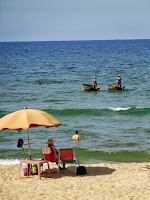As we continued our loop through Southeast Asia, our first stop in Cambodia was the obligatory one: Siem Reap, home to the Angkor complex. Although the UNESCO-recognized archaeological park is the main attraction, the city itself is a nice place to take a stroll. Siem Reap is bisected by a river that flows into Tonle Sap, the largest freshwater lake in Southeast Asia. Along the river you can catch glimpses of how life is and was lived along the water, including the drying of wetland herbs and flowers (left). Some communities build water wheels to collect and use the kinetic energy of the water flow (right).
Speaking of kinetic energy, the vibrant center of Siem Reap at night is "Pub Street." You can probably tell from its name and its neon that it caters to tourists; it's somewhat like Bourbon Street during Mardi Gras, but with fewer bead-throwing taunts and cheaper "big-ass" beers (left). But if you go down some of the side streets, you can find some more enjoyable waterholes, including Asana, a bar built into the last wooden house in the middle of the city (right).
The very atmospheric treehouse was surprisingly quiet, considering how many tourists were in town to see Angkor. We were lucky enough to get away from the crowds on Pub Street -- and in Angkor. Most people hire a tuk-tuk to tour them around the complex; we opted to use bikes in an attempt to get off the tuk-tuks' route and schedule. We used our own to feet to get us first to a lesser-visited temple, Baksei Chamkrong, where we used our own two feet again to climb the very steep steps (left). They were so steep that TJ and I both decided to climb down backward, as if on a ladder (right).
For the moment, we sideskirted Angkor Wat, which seemed inundated with people, and headed to Angkor Thom. We approached through the south gate, where the bridge over the moat is lined with a series of very impressive statues riding a snake (left). In the middle of Angkor Thom lies Bayon, a structure known for its many built-brick-by-brick faces (right). We spent quite a while crawling through Bayon's crevices, always finding even-more-detailed carvings.
Next up was Ta Phrom, pitched as the set for Lara Croft: Tomb Raider. Never having seen the movie, I had no desire to envision Angelina Jolie climbing its walls, especially when the local children were so skillful themselves (left). Instead, it was at the top of my "must-see list" because of how nature has invaded the structure, somehow making it even more beautiful (right).
After lunch, by the second half of the "small circuit," we didn't stop for more than a cursory glance or photo opp at any more temples. Nonetheless, we enjoyed cruising the countryside, at a quick clip, so we could reach Angkor Wat by closing time. The temple city is what first drew attention to the area, and upon looking at the complex architecture, it's no surprise why (left). The temple is supposed to be spectacular for sunrise, but it was equally stunning at sunset (right).
In every country with beaches, we vowed to visit the capital and the coastline. Unfortunately, after the brilliant weather and sights at Siem Reap, our choices lacked luster. Although Sihanoukville is very popular, it didn't quite fit our beach profile: We're too cheap for the full-service resorts, but we're too old for the back-packer shacks. We ended up staying at some mid-range bungalows abutting some fancier boutique hotels. In high season, they're probably quite nice, but being in Otres Beach II, we were very far from anything but the sand, which was not as fun without the sun. Still, we managed to enjoy some pleasant breakfasts while watching the waves (left). In between the cloudbursts, we made our way to Ocheteaul Beach (right). But we didn't stay long because it looked as if it were suffering from a hangover, much like many of the people who frequented its party bars the night before.
On our way to Ocheteaul Beach, the clouds cleared long enough to take a dip at Otres Beach I. We bought a few drinks so we could occupy a beach bar's reclining chairs. Even with the gray weather, it was relaxing enough -- when we weren't being bothered by tour touters and pedicure purveyors, both of which ply the area's long stretch of sand.
In a strange way, packed Phnom Penh was a welcome change, as we could sink anonymously into the crowd. The capital is full of great markets to get lost in, including Psah Thom Thmei, the central market that can be spotted from miles away because of its huge dome (left). The promenade along the Mekong River usually is quite crowded, although it cleared up by the time we stopped for a snack at the well-known Foreign Correspondents Club, which seemed more like an Applebee's imitiation than a journalists' institution (right).
We started our tour of Cambodia with a survey of ancient history, and we ended it with an investigation of the more recent past. Tuol Sleng Genocide Museum was created in the ruins of the S-21 prison run by the Khmer Rouge. The Pol Pot regime converted the prison from a school, covering its walkways with barbed wire (top right) and knocking down its walls to create cell blocks (top left)). In the cells, political dissidents were chained, tortured, and even killed (bottom left). Fourteen people found dead when the prison was discovered are immortalized in graves on the grounds and -- quite disturbing -- photos on the walls; in fact, dividers have been added in order to display the many "mug shots" of prisoners (bottom right).





































































